
Table Of Content
From Cart Abandonment to Conversion: The Human Problem AI Can Actually Fix

The Challenge
Maya stared at the product page for seven straight minutes. A navy blazer sat in her cart, paired with two white blouses and some ankle boots. The total glared back at her: $347. She switched tabs, checked her bank balance, and switched back. The shipping estimate was another $18.99. She made a face, closed the laptop with a definitive click, and walked away.
The blazer stayed there, forever unpurchased.
This isn’t a rare story. According to the Baymard Institute, 70% of online shopping carts are abandoned before checkout. Think about that. Seven out of ten people who are ready to buy simply change their minds.
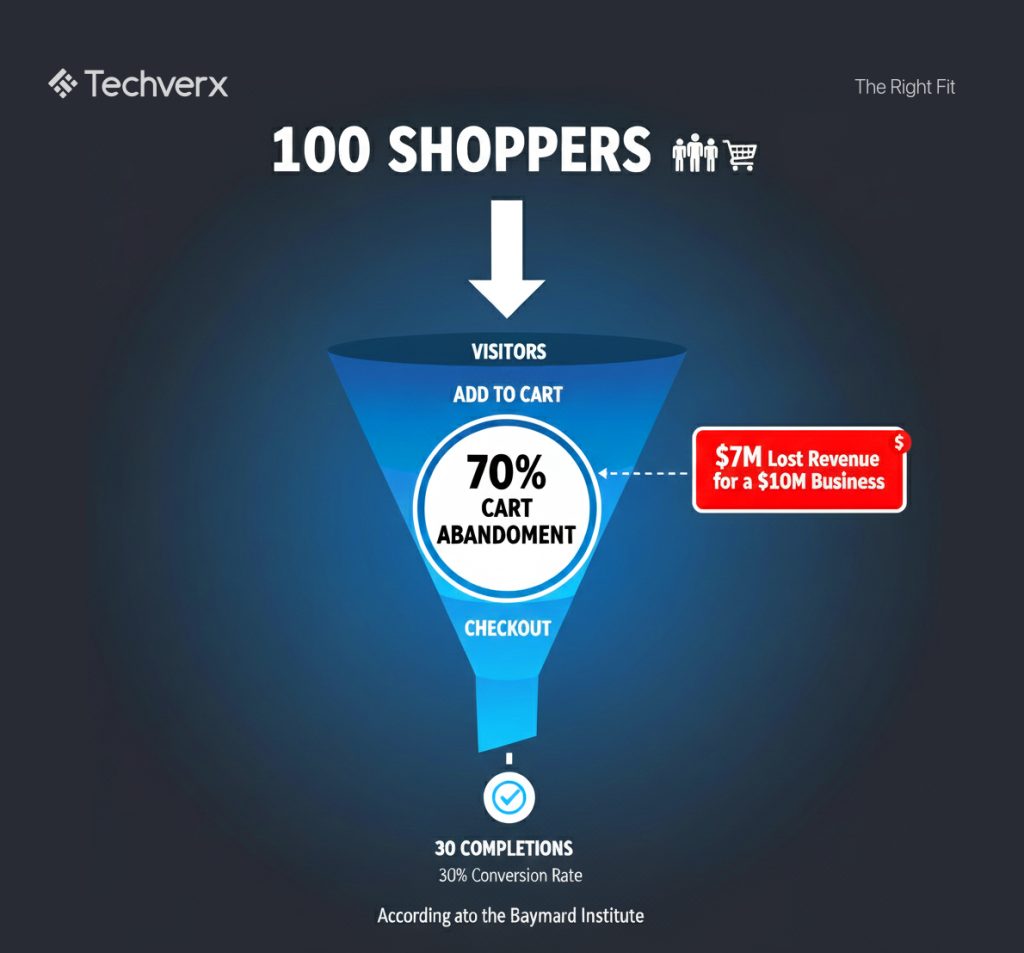
For a store pulling in $10 million a year, that’s $7 million in potential revenue vanishing into thin air. If you could claw back just 15% of that, you’d add over a million dollars to your bottom line without chasing a single new customer.
We know why this happens. Almost half of all abandonments are thanks to surprise shipping costs. Another quarter comes from websites forcing you to create an account. The rest are lost to checkout processes that feel like filing your taxes.
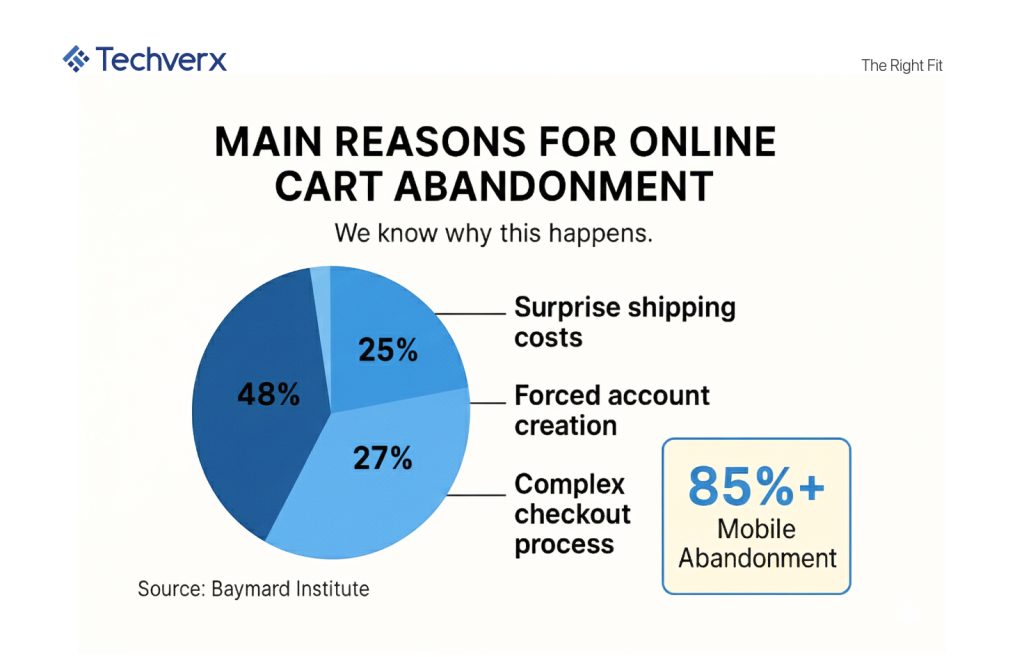
It gets worse on mobile, where abandonment rates can shoot past 85%.
McKinsey estimates generative AI could create up to $390 billion in value for retail. But most stores are still stuck in the past. They treat cart abandonment as a technical glitch in the checkout line, when the real breakdown is much deeper.
When Maya hesitated over that blazer, she needed a voice telling her it was a smart purchase. She needed confidence about the fit, a reminder about free returns, maybe a tip that it would look great with the jeans she already owns. In a physical store, a good sales associate would have seen her lingering and offered help.
Online, she got nothing but silence.
That silence has a price tag, and it costs businesses billions every year.
The Myth
Most retailers are patting themselves on the back for “solving” cart abandonment with a basic email campaign.
You know the one. Wait a day, then send a “Did you forget something?” email with a generic 10% off coupon. Set up the automation, forget about it, and feel good when the recovery rate ticks up a few points.
Teams convince themselves this works because they see a trickle of conversions. A 3-5% recovery rate feels like a win when you’re dealing with such a massive leaky bucket.
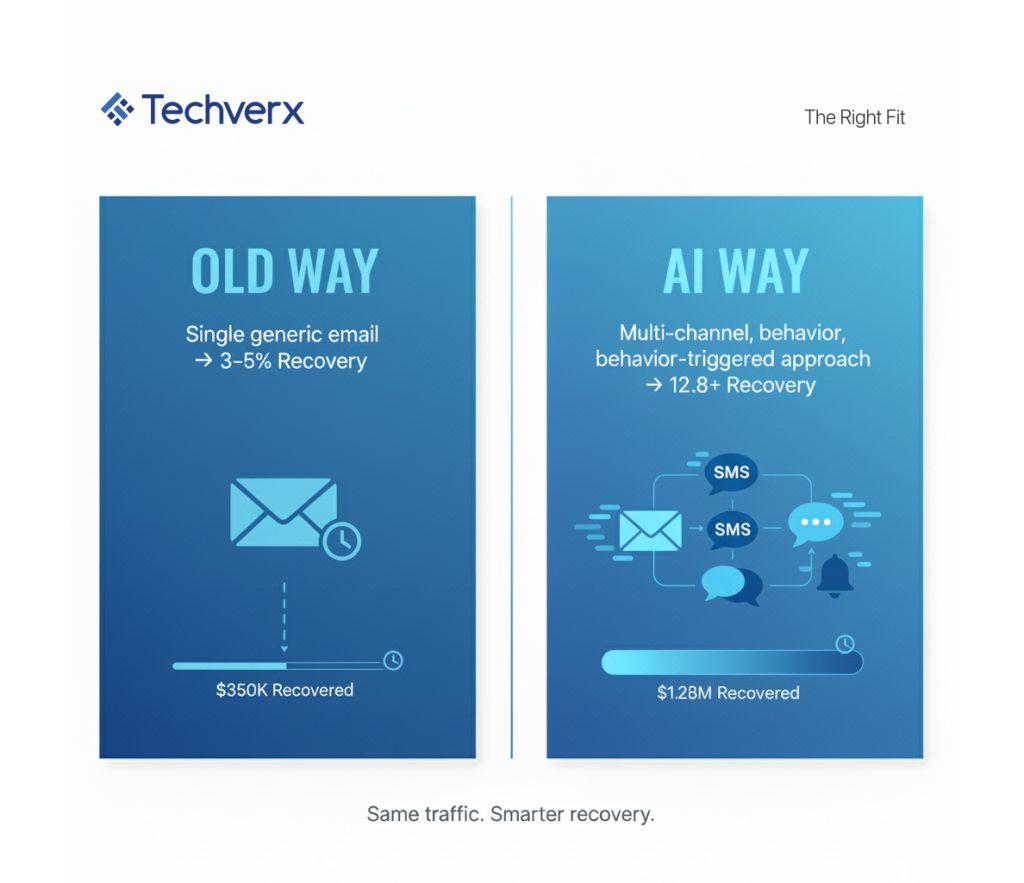
The logic seems sound on the surface. Remind people. Offer a small bribe. Make it easy to come back.
But those recovered carts are just the low-hanging fruit. They represent a tiny fraction of what’s actually possible. McKinsey and the Retail Industry Leaders Association report that only 15% of retailers use omnichannel personalization effectively. That means 85% of brands are treating every abandoned cart the same, whether it belongs to a first-time visitor comparison shopping or a loyal customer who just got distracted.
This myth survives because it’s easy. Automating a single, bland solution is simpler than building a smart system that responds to individual people. But easier isn’t better.
McKinsey research shows that 71% of consumers now expect personalized interactions, and 76% get genuinely frustrated when it doesn’t happen.
Your generic recovery emails aren’t solving the problem. They’re just collecting the easiest wins while leaving the real money on the table.
The Insight
Let’s be clear. Cart abandonment isn’t a checkout problem. It’s a conversation that never happened.
The brands recovering the most revenue have stopped thinking about abandoned carts as a single failure point. They’ve started treating the entire purchase journey as a series of tiny decisions, where customers need different kinds of support at different times.
This is where AI changes everything. It can spot hesitation patterns a human could never see at scale. A shopper who views a product page four times over two days is telling you something very different from someone who lands once and bounces. A person who spends five minutes on the cart page needs a different kind of help than someone who abandons in 30 seconds.
Take one home goods retailer. They ditched their generic emails for AI-powered behavioral triggers. Their system detected hesitation as it happened. If someone camped on the cart page for more than five minutes, a chat window opened with a simple message: “Need help deciding? I can answer questions about sizing, shipping, or returns.”
Their cart recovery rate hit 12.8%. That’s more than double the industry average.
The magic wasn’t the discount. It was the timing and the relevance.
In 2024, AI-driven recommendations influenced $229 billion in e-commerce sales, accounting for nearly one-fifth of all online orders, according to Salesforce. The brands capturing that value have woven AI into every single customer touchpoint.
Here’s what actually moves the needle.
Before abandonment even happens, AI tracks micro-behaviors, time on page, how far they scroll, repeat visits, to predict hesitation. If someone lingers on a product, the system can offer real-time help via chat or show social proof like “342 people bought this yesterday.”
At the moment of abandonment, exit-intent popups get clever. AI tailors the offer based on cart value and user history. High-value cart? Offer free expedited shipping. A price-sensitive shopper? Show them payment plan options. A repeat customer? Remind them about the loyalty points they have waiting.
After abandonment, recovery sequences become multi-channel and behavior-driven. Email, SMS, push notifications, and retargeted ads work together like a team. Each message builds on the last. If the first email gets ignored, the second one adjusts its message based on that reaction.
One fashion retailer using this approach saw click-through rates jump 32% by tailoring emails to the specific items left behind. Someone who abandoned a dress got styling tips. Someone who left shoes got fit and sizing guidance.
The real goal is for AI to anticipate friction and remove it before the customer ever thinks about leaving. That’s where you find the unlocked revenue.
Gartner predicts that by 2030, AI will drive a profound shift in digital commerce toward true customer centricity. This transformation is already happening. The brands that master personalization today will be the ones dominating tomorrow.
The Framework
Building an AI-powered cart recovery system that actually works requires four layers. Skip one, and the whole thing will underperform.
1. Get Your Data House in Order
AI is a garbage-in, garbage-out machine. Feed it incomplete product info, outdated inventory, or messy customer profiles, and it will spit out irrelevant recommendations that push people away for good.
Every product needs rich metadata, not just a title and price, but details on material, fit, seasonality, and use case. Schema.org markup helps AI understand how products relate. If someone buys running shoes, the AI should suggest moisture-wicking socks, not patent leather loafers.
Connect your AI to inventory systems, CRM platforms, and order databases in real time. There is no faster way to destroy trust than to recommend an item that’s out of stock or to ignore something the customer just bought. One major retailer lost nearly a quarter of its AI-driven conversions because their inventory data only updated once a day.
You also need persistent memory. Stateless systems forget a user between sessions. If Maya abandons a cart on Tuesday and comes back on Friday, the AI should remember her, not start from a blank slate.
Accenture talks about AI systems that predict family needs and restock household essentials automatically. That level of intelligence needs an infrastructure most retailers simply don’t have yet.
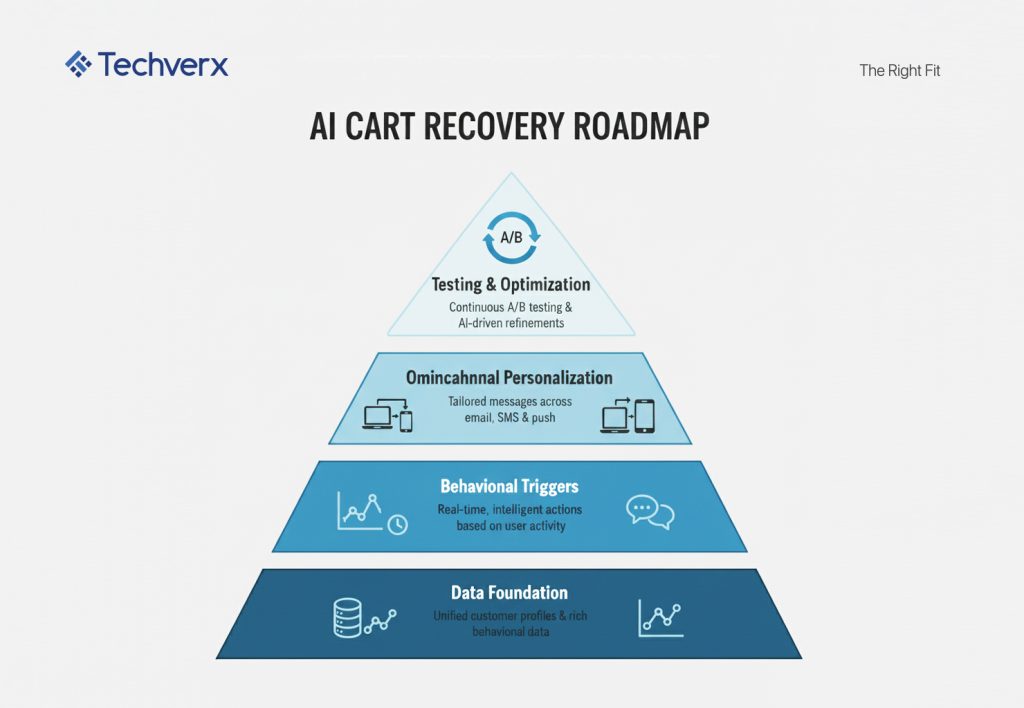
2. Use Behavior, Not Just a Clock
Time-based triggers are always late to the party. Behavior-based triggers catch people in the act.
Instead of sending an email 24 hours later, trigger a message the second a user shows exit intent or after five minutes of cart inactivity. One retailer using this method recovered 14% of their abandoned carts within the first hour alone.
Let the AI determine the smallest incentive needed to convert, based on the customer’s lifetime value, what’s in their cart, and competitor pricing. Your best customers might only need free shipping. A new visitor might need a first-purchase discount. A serial browser might just need a simple reminder.
Smart inventory alerts can use scarcity, but only when it’s authentic. AI can track inventory levels and user interest to send a targeted nudge: “The jacket you viewed is down to one left in your size.” This works because it’s timely, specific, and true.
3. Personalize Across the Entire Board
Your customers don’t think in channels. They browse on Instagram, research on a laptop, and finally buy on their phone.
AI that unifies these touchpoints, remembering preferences, syncing carts, and delivering a consistent message, creates a seamless experience that builds real loyalty.
The top brands run the same AI brain across email (for behavior-triggered recovery campaigns), SMS (for time-sensitive offers to high-intent users), web chat (for instant checkout support), social media (for retargeting with AI-optimized ads), and mobile apps (for push notifications with location-based deals).
McKinsey and RILA report that a mere 15% of retailers have fully implemented cross-channel AI strategies. That’s a huge gap, and it represents a massive opportunity for anyone willing to move first.
Start by unifying email and your website, then expand from there. Consistency is what builds trust.
4. Never Stop Testing and Tweaking
AI personalization isn’t a project you finish. It’s a living system. User behavior changes. Market conditions shift.
The most successful implementations are in a constant state of testing, learning, and optimizing. What worked last quarter might be completely stale today.
You need to test the messaging tone, the types of offers, the timing intervals, and the channel combinations. Measure recovery rates, average order value, customer lifetime value, and engagement metrics across every touchpoint.
McKinsey found that generative AI could boost marketing productivity by 5 to 15% of total spending by automating personalized interventions. The brands capturing that value treat AI as a revenue driver, not a cost center.
But watch out for the creep factor. When AI gets too personal—reminding a customer they viewed a product three times or stalking them across the internet—it backfires spectacularly. The line between helpful and invasive is very, very thin.
The best AI feels invisible. Customers don’t think, “Wow, that’s clever AI.” They think, “This store gets me.”
The Outcome
Let’s be realistic. Cart abandonment will never hit zero. Some browsing without buying is natural, even healthy.
But losing 70% of your potential sales to problems you can fix? That’s a choice. It changes the moment you deploy intelligent personalization.
The gap between a 70% abandonment rate and a 55% rate is not trivial. For a $10 million retailer, that’s $1.5 million back in your pocket. For a $100 million brand, it’s $15 million.
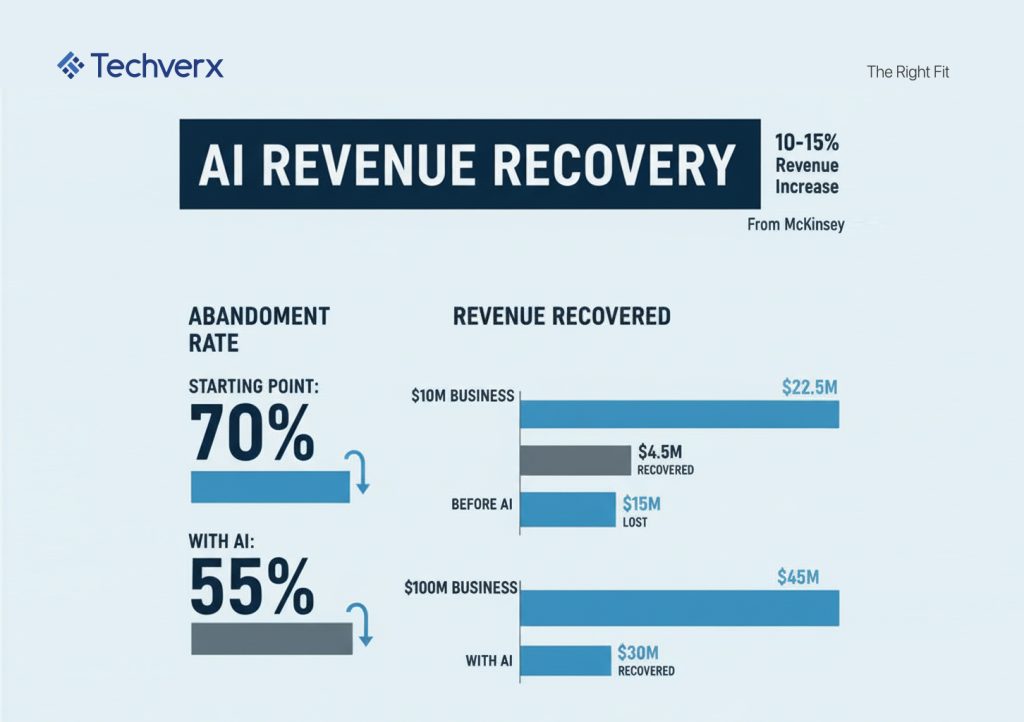
Stop Losing Carts & Start Gaining Customers
Top retailers using AI-driven personalization see revenues and customer retention rates that are 10-15% higher than their peers, according to McKinsey. Deloitte research shows these leaders are 48% more likely to exceed their revenue goals.
The advantage is clearest in mobile commerce, where abandonment rates often exceed 85%. Brands that build AI for mobile-first experiences, think simplified checkouts, one-tap payments, and predictive product suggestions, are eating the lunch of competitors who still treat mobile as an afterthought.
The brands investing in this AI infrastructure today are building a moat that competitors will struggle to cross for years. First-mover advantages here compound, because every single customer interaction generates new data that makes the system smarter.
And Maya, the shopper who abandoned that navy blazer? Two days later, she got an email. It wasn’t a generic “You forgot this!” message with a discount code. It showed the blazer styled three different ways with items she’d looked at before. It mentioned free returns. It quietly noted that inventory was low in her size.
She clicked. She completed the purchase. She even added one of the suggested blouses.
That’s the power of using AI to serve the customer, not just chase a cart.
Technology should make customer relationships stronger, not replace them. The brands that understand this—that use AI to enhance human connection instead of eliminating it, will build a kind of loyalty that doesn’t care about price, platform, or product.
If you’re still relying on generic recovery emails sent a day too late, you’re competing with one hand tied behind your back. The infrastructure exists. The data proves it works. The only question left is whether you’ll use it before your competitors do.
At Techverx, we build the AI infrastructure that turns abandoned carts into completed purchases.
Our team specializes in Azure, Dynamics 365, and enterprise AI integration, creating personalized customer experiences that drive measurable revenue growth.
From data unification and MLOps to cloud-native delivery and security-first architecture, we handle the technical complexity so you can focus on results. Whether you’re implementing smart cart recovery, deploying real-time recommendation engines, or scaling omnichannel personalization, we bring the expertise to make AI work at enterprise scale.
Let’s build your roadmap.

Hannah Bryant
Hannah Bryant is the Strategic Partnerships Manager at Techverx, where she leads initiatives that strengthen relationships with global clients and partners. With over a decade of experience in SaaS and B2B marketing, she drives integrated go-to-market strategies that enhance brand visibility, foster collaboration, and accelerate business growth.
Hiring engineers?
Reduce hiring costs by up to 70% and shorten your recruitment cycle from 40–50 days with Techverx’s team augmentation services.
Related blogs


